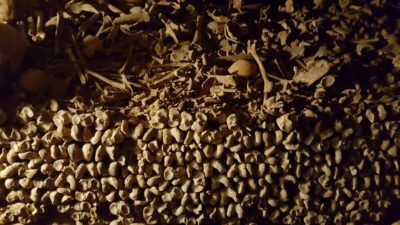
The Catacombs Are Seriously One of the Coolest Things in Paris
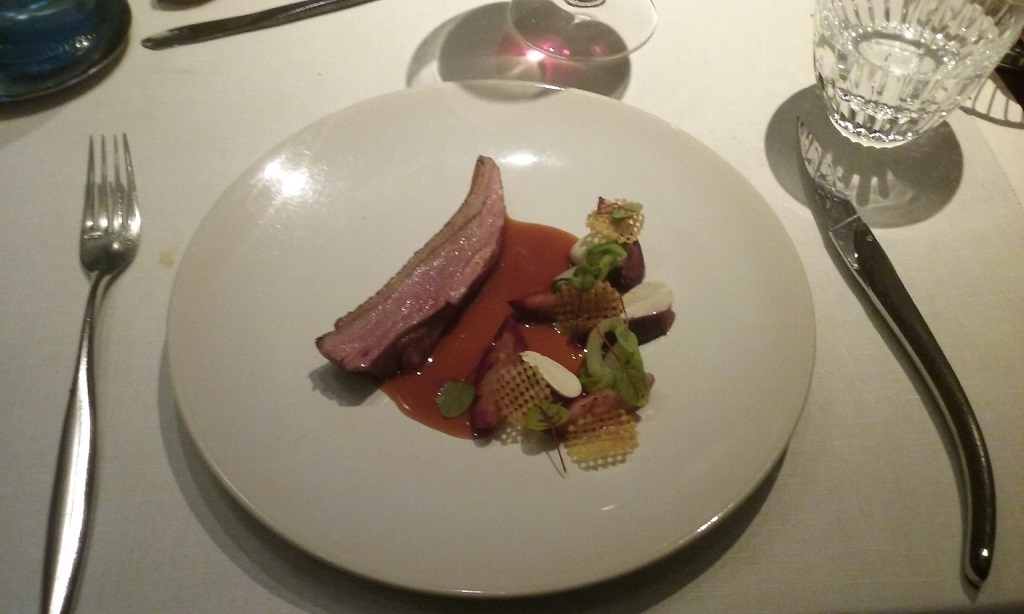
The Challenged Duck Was No Challenge for Us to Eat
Oct. 7: We are back from what has become our annual dinner at Anne-Sophie’s. Our busy day started out with what has become our annual attempt to visit The Catacombs. Two years ago, we showed up bright and early on a Monday morning only to discover that The Catacombs are closed on Mondays. Last year we showed up on a Saturday afternoon to discover we would have needed to wait for hours in line to enter.
Our friend Sonja was in Paris this summer and one day over lunch she told us that it took her three attempts as well to finally get in, although for her it was over three days. She encountered a closed day; a long line day; and on the third day she made sure it was open and got there an hour early. Trying to gleam a little wisdom from the situation, we woke up early and swung from the hips to walk there, as they are in Montparnasse.
The Catacombs of Paris are an ossuary, a human bone depository, which was created in the late eighteenth century. It may seem like a strange or rather unpleasant destination, but it was a fascinating and totally engrossing experience, one that weaves so much of Paris history into it. It was all the more engrossing, because of a completely random and arbitrary event.
As we were standing in line waiting for entry, Victoire, a young guide who gives tours through the Catacombs, came down the line asking people if they had booked a tour. She had a group of clients that she could not find. Dan approached her and said we weren’t her client, but that, if she couldn’t find them, we would be happy to have her as our tour guide. She agreed to that, although she continued to give a valiant effort to connect with them if possible. Dan and I continued to chat and watch Paris wake up for the day. Forty five minutes went by and Victoire found us and told us she could be our guide. It turned out to be a wonderfully fortuitous event!
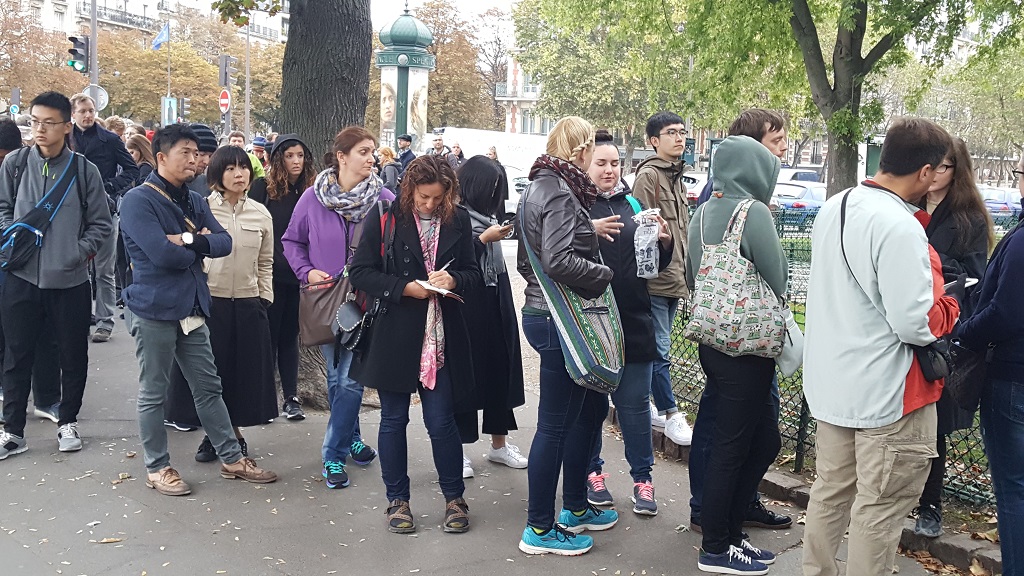
The Line Was Growing Long before the Catacombs Even Opened
To understand how the Catacombs came to be, let’s get a basic understanding of the geology of the region. Many years ago an ancient sea laid down the deposits that would ultimately become limestone overlaying the Paris region. Fast forward fourteen million years and that limestone was quarried to build – quite literally – Paris. Most of the buildings that we know and love, like Notre Dame, were built with that very same limestone.
In the early days the limestone was quarried from surface quarries, but the good Parisians quickly realized that they would chew up all their valuable real estate with surface quarries, so they moved to underground mining. This created a vast network of underground tunnels. When this was being done, the quarries were located outside the city. Although as Paris grew, what used to be outside the city, eventually became part of the city. So today, there are several hundred miles of these tunnels running beneath Paris.
In parallel with the limestone quarrying, as Paris grew and developed through the ages, its citizens, naturally enough, died. They were buried without caskets near their churches so that they would always be close to God. This was fine for a while but as more and more citizens died and as the plague swept through Paris and added even more, the “cemeteries” essentially became big holes with no more space in the inn. So the Parisians began to stack the bones into walls around the burial grounds.
When the death rate was high, the bodies were being dug up before they had even rotted. So half decomposed corpses were being stuffed into the walls and it wasn’t long before there were even more problems. Hygiene and public health suffered as the bodies rotted and bodily fluids ran into the streets and begin to pollute the water and air.
At the same time, a separate problem was forming as a result of the limestone quarries. All the mining was destabilizing the land. People were saying that Paris was like Swiss cheese, with all the holes in it. At some point, an entire house was just swallowed up by the earth. The citizens already lived with plenty of fear about God, and when this happened, it became proof that there were demons out to get the sinners.
Finally the situation became untenable in the late 1700’s and they decided that something had to be done with the bodily remains. Some clever person remembered the underground quarries and suggested taking the surplus of mass (the bones) and using it to fill the deficit of mass (the quarries). Thus the Catacombs were born!
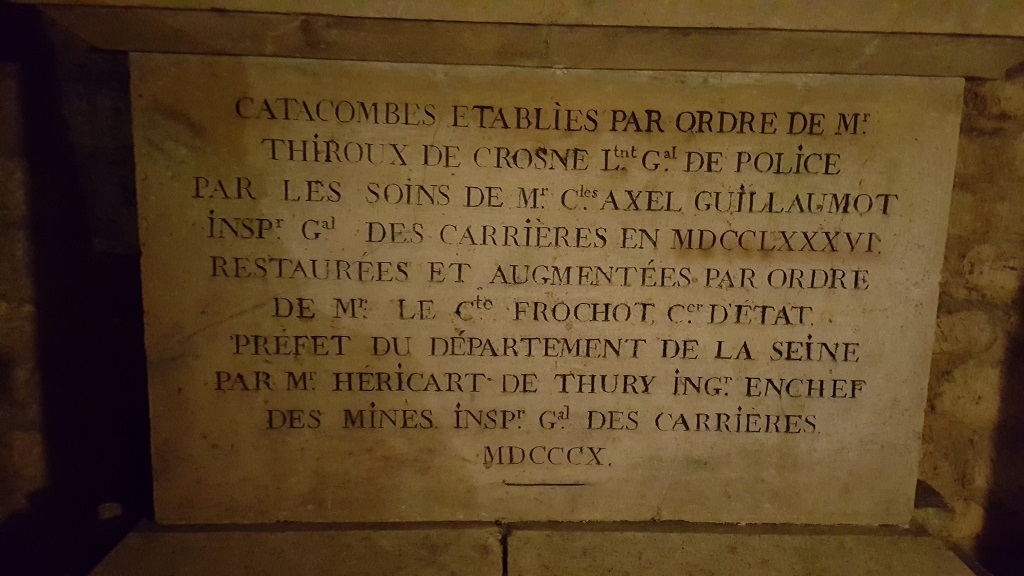
Plaque Commemorating the Establishment of the Catacombs in 1786
Victoire had laid the foundation for us in the museum section before we entered. Then it was time for us to enter and Dan and I, with packs on our chests so that we did not bang the walls, were excited and engaged every moment.
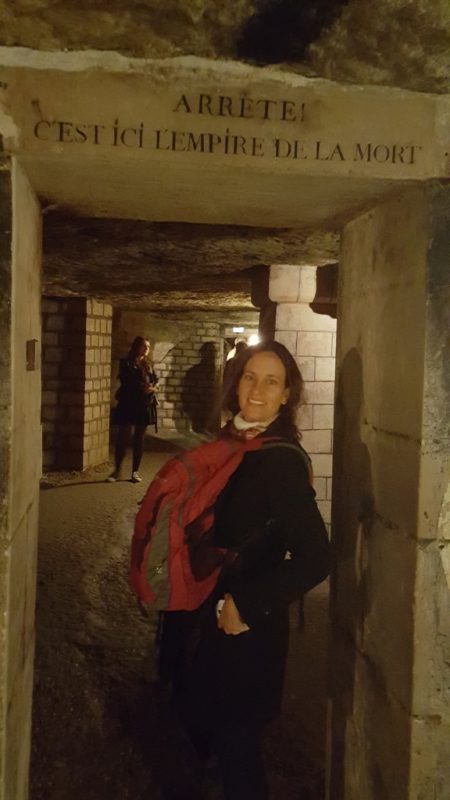
Enter the Catacombs
Each of the passages is carefully marked by who was responsible for establishing the passage and when they did so:
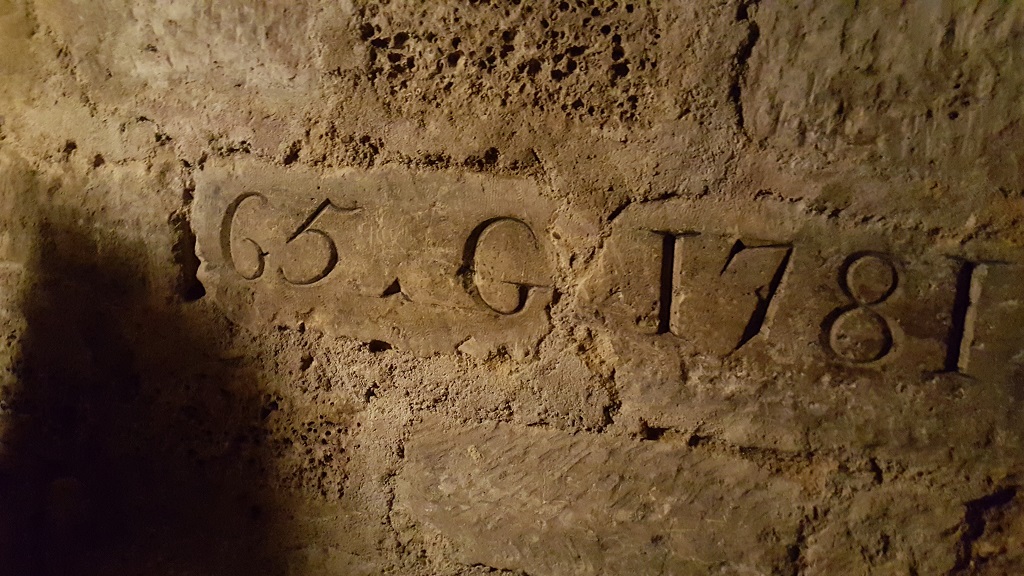
Passage 65 Established by the Quarry Person Guillaumot in 1781
The Tunnels had the same names as the streets that ran above them. As Paris has evolved through the years, some streets have been replaced by others. The Catacombs is a preserved map of an earlier Paris!
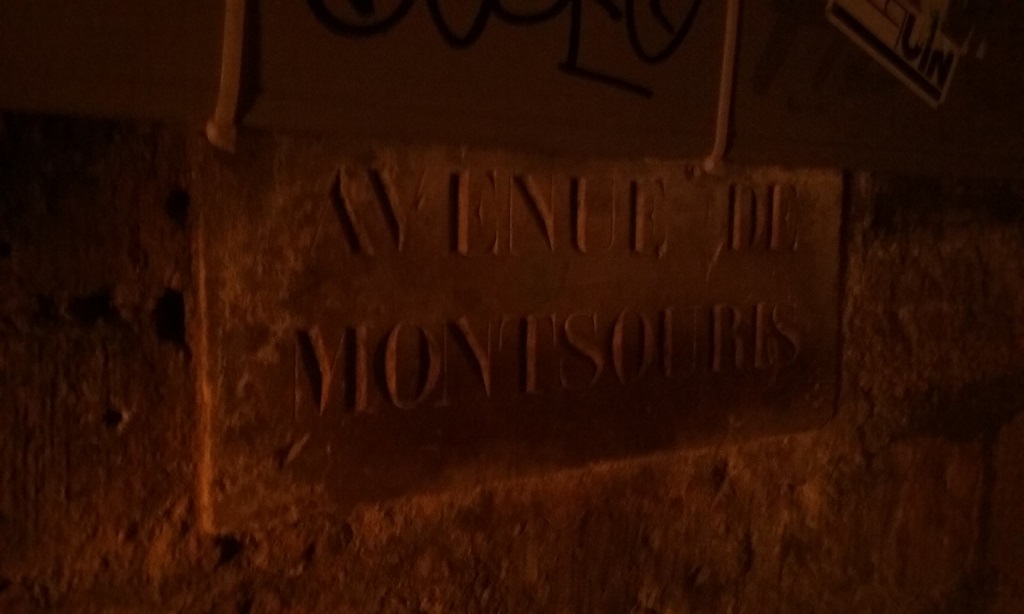
Avenue de Montsouris: The Tunnel Corresponds to the Street Above Ground
And here is a typical wall. Large bones like skulls and femurs were used to build a sturdy wall along the passage and then the smaller bones were piled in behind the wall to fill the quarried space. This building technique was developed in Italy and is called hagues et bourrage. The literal translation is stone walling and back filling (with debris).
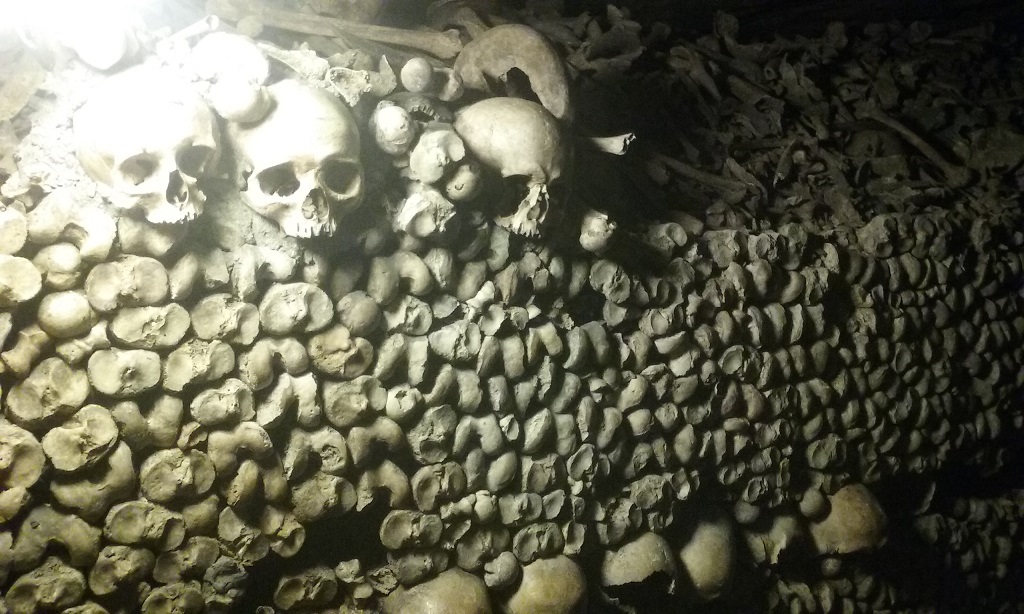
Typical Wall
And all of the walls were marked with plaques giving the cemetery where the bones originated:
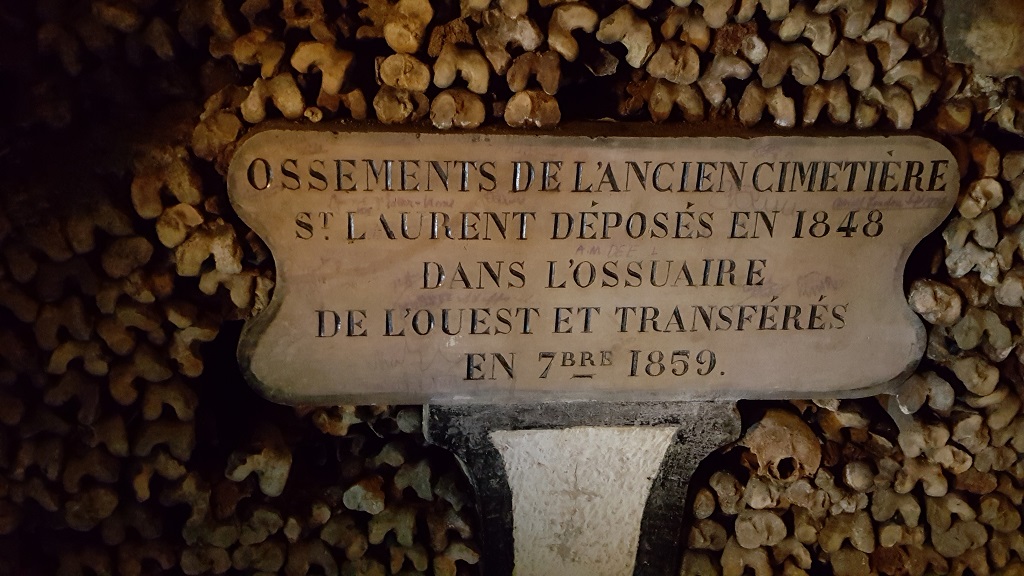
These Originated at the Cemetery St. Laurent
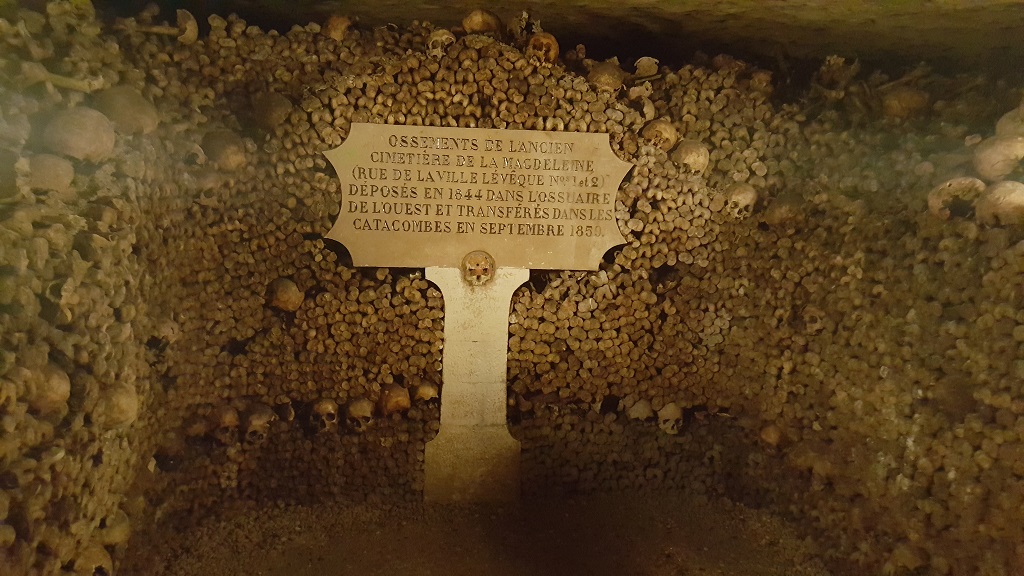
And these bones originated from the cemetery where the bodies of people who faced the guillotine in the French Revolution were dumped. It is thought that Louis XVI’s bones may be in here, but Marie Antoinette’s bones were most likely removed.

And these bones originated from the cemetery where the bodies of people who faced the guillotine in the French Revolution were dumped. It is thought that Louis XVI’s bones may be in here, but Marie Antoinette’s bones were most likely removed.
Thanks to Victoire’s explanations, the bones and skulls in the walls told a variety of stories:
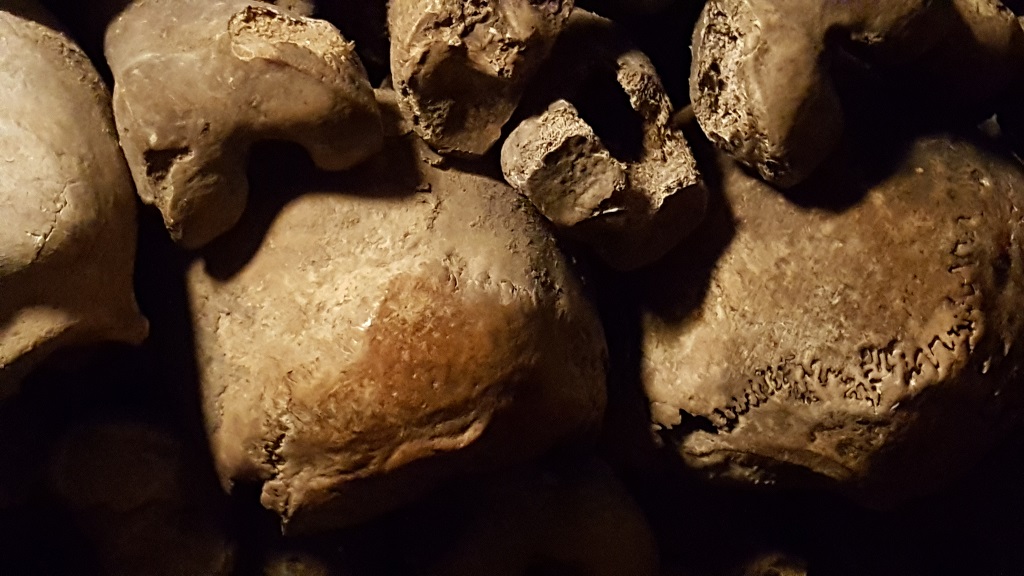 The Brown Mottling on the Skull to the Left of Center Indicates that the Poor Person to the Left of Center Died of the Plague
The Brown Mottling on the Skull to the Left of Center Indicates that the Poor Person to the Left of Center Died of the Plague
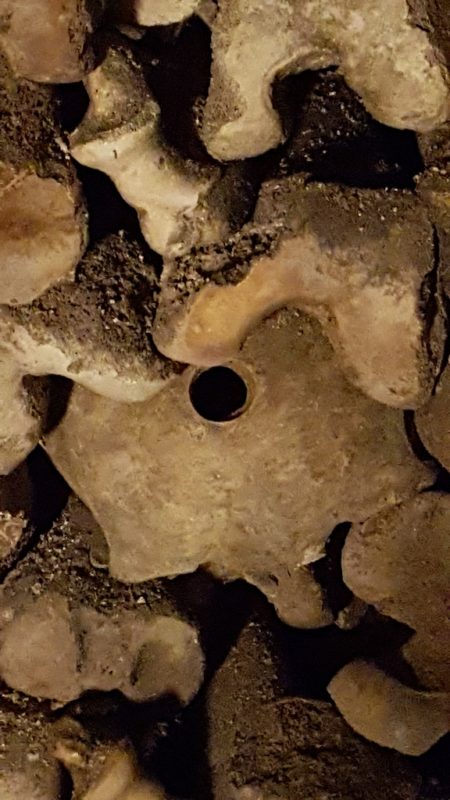
This Person Had a Type of Brain Surgery that Was Common at the Time
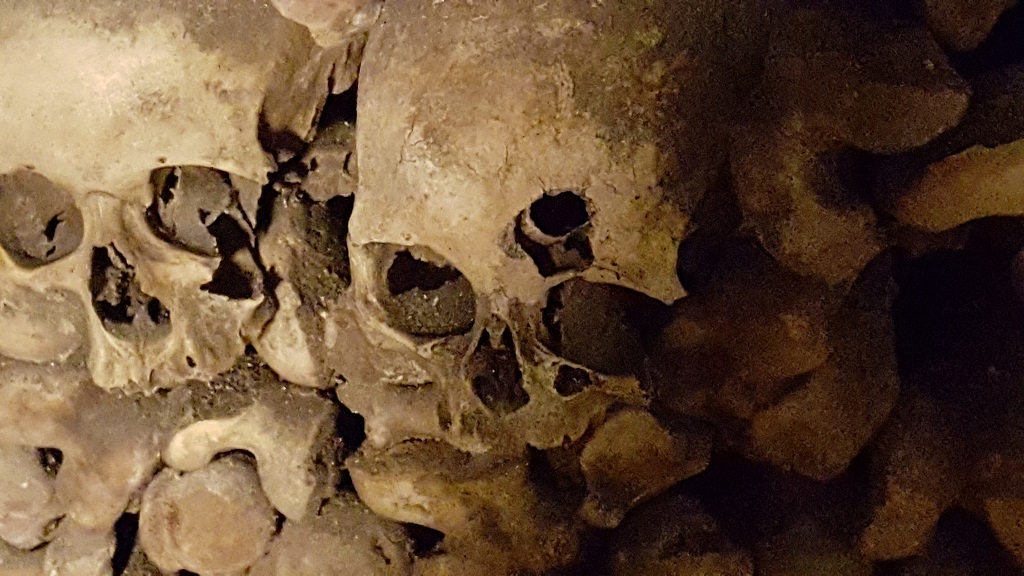
Note the Bullet Hole above the Eye in the Skull in the Center
Now the question is how did a person who died long before guns were in widespread use have a bullet hole in his or her head? Thanks to Victoire, we now know the likely answer. It turns out that the participants in the Paris Commune in the 1850’s who had an unsuccessful uprising against the State tried to hide in the Catacombs when the soldiers came to repress them. This is the same event that resulted in the destruction of the Royal Tuileries Palace. In the case of the Catacombs it resulted quite a bit of gun fire and more dead bodies, as well as a lot of random bullet holes in the skulls.
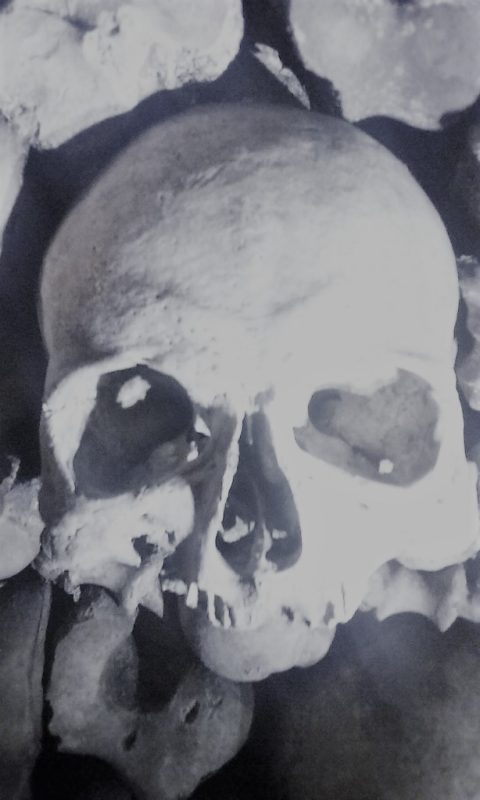
Note the Tiny Holes Around the Eyebrows- This Signifies This Person Died of Syphilis
As you can already infer, Victoire was a very interesting and engaging person. One of the reasons she knew so much about the Catacombs is that she is a cataphile, one of several hundred persons who have a passion for exploring and preserving the larger set of Catacombs underlying Paris. The cataphiles are much like urban spelunkers, who enter into the old limestone quarries to explore, but also to attempt to preserve them. For example, when they find walls that are threatened with collapse, they repair them. Formerly, they would report them to the authorities, but when the authorities began to just fill up the passage in question rather than repair it, the cataphiles started taking it upon themselves to do the repairs.
Victoire now spends the six warm months of the year in Paris leading tours of the Catacombs and other sites and the other six months traveling. After traveling to China for two years and learning Mandarin, she will soon be headed to South America this winter. Quite a different trajectory than most 25 year old Americans!
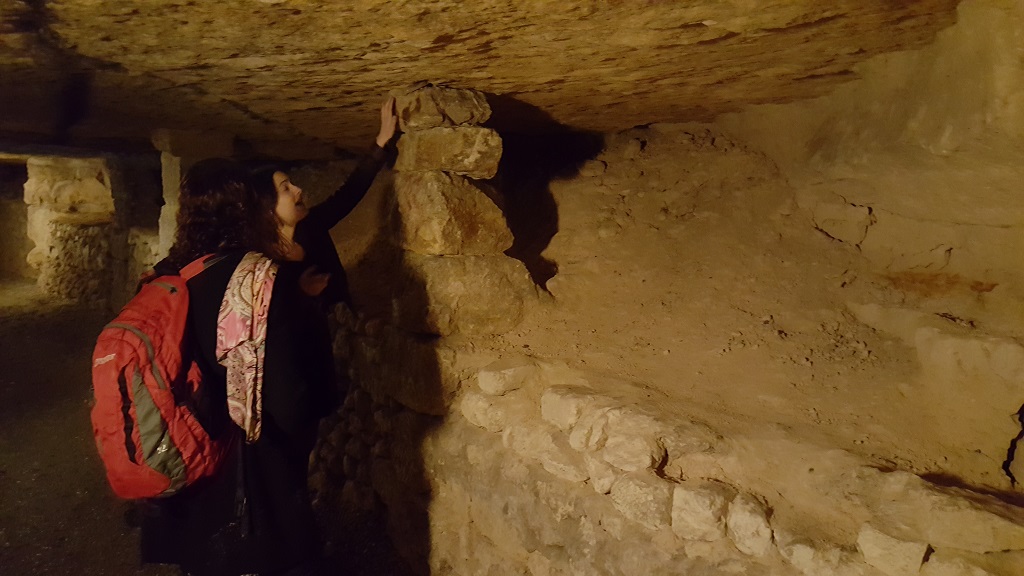
Victoire Pointed out How People Stabilize the Weak Points of the Tunnels, to Prevent a Collapse
Our visit to the catacombs took a lot longer than we anticipated, because Victoire took things slow so she could fill in a lot of details. But it was SO worth it. I hesitate to say, it was worth waiting a couple of years to make it happen. After all, so much of life depends on timing.
Checking out the Pasteur Museum got cut as a result of the lengthy visit to the Catacombs, but perhaps we will go there next year. When it is combined with some other wildly fortuitous event, we will know that it was the right thing that it took us years to get there too. So we walked home and I cooked up a simple lunch and then we decompressed a bit. We often take these types of breaks to get ahead, or more accurately, catch up, on blogging.
The next main event of the day was dinner at La Dame de Pic, Anne-Sophie Pic’s Paris restaurant. As I said in the introduction, dining with Anne-Sophie has become an annual tradition for us. Last year we had a fabulous experience at her three-star restaurant in Valance. This year is was La Dame de Pic.
The restaurant is up by the Louvre. By total coincidence, we were seated at the same table that we were at two years ago. I had a great view of the open kitchen, but Dan was facing away from it. There was some choice within the tasting menus and we made sure that our orders together created the most variety and a complementary meal.
Something that seemed like every day fare, like a farm egg with Paris mushrooms, should not be underestimated, when Anne-Sophie creates the dish. There were finely chopped mushrooms at the base, with a thin layer of whole (but tiny) mushrooms on top of that, topped with a large poached egg with a runny yolk. Paper thin mushrooms surrounded the egg and formed a wall to hold it all together. A mushroom consommé with ginger was poured on top of it once it was delivered to the table.
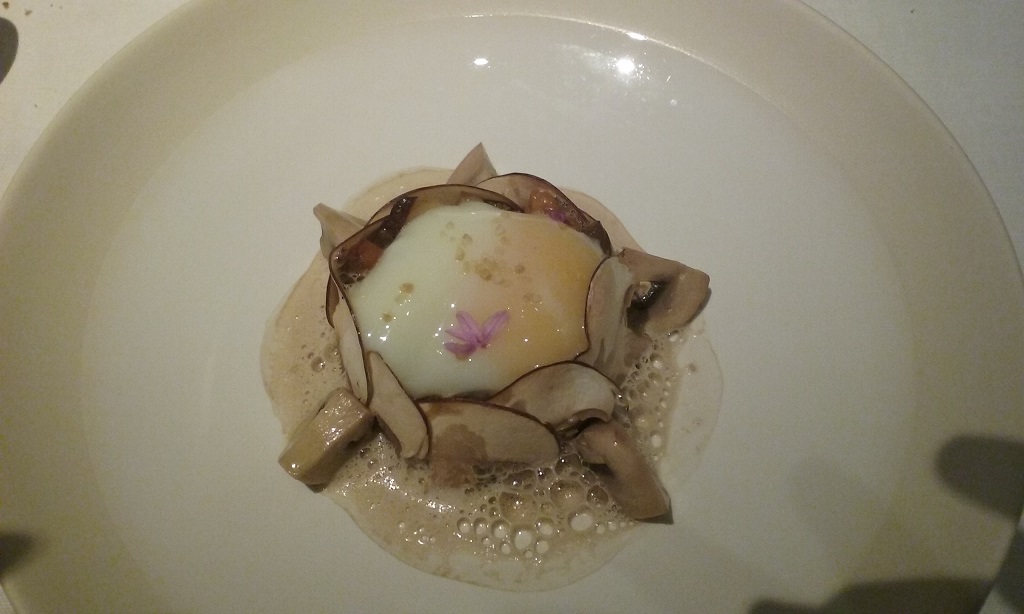
Egg and Mushroom Like You Have Never Had Before
The Challenged Duck as she called it was a small slice of roasted duck, roasted with thyme, peaches, and almonds. She then used her version of a bigarade sauce to complement and tie the seemingly unrelated flavors together.

The Challenged Duck Was No Challenge for Us to Eat
Every dish was a masterpiece and deserving of praise. Her portions are appropriate, her flavor combinations are unique and utilize lots of floral and herby flavors. Her plating is amongst the best we’ve seen. I had a hard time deciding which pictures would go on the chopping block for this blog entry. So lo and behold, I am showing you a wide array of her edible handiwork.
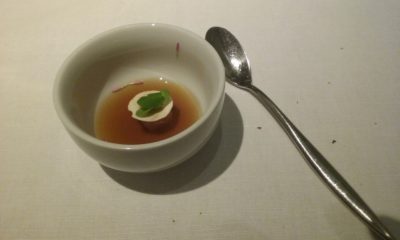






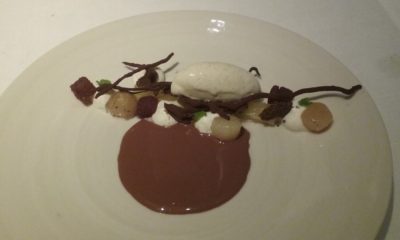
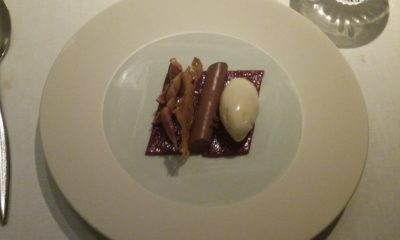
We did ding them a little bit for the service. The service while good was at times abrupt and rushed. They would bring one dish and realize they forgot to bring both at the same time. Then they would get the other dish and walk away without explaining the food.
To no discredit of Anne-Sophie, but we observed Paris is getting less formal than most of us envision and some of us know, if we’ve been visiting for years. For example, on this occasion men came in looking like shlumpidinks, wearing Levis with the shirt tails flying. We realize for people who live here or close by, it’s not as special of an event as it is for us. That being said, spending fifteen minutes getting your act together would be greatly appreciated and elevate the dining experience for other patrons.
Although it was out of the way, I suggested going to Notre Dame in a circuitous route to get home. Even at 11pm, it was hopping! We witnessed a scene that we both found amusing. Although I could only speculate on what was happening, Dan understood the exchange. Once he filled me in on the details, I found the entire situation that much more amusing. There were a group of French hacky sack players who were bothered by the blasting rap music played by a couple of Algerian teenagers. Anyway, they engaged in a serious negotiation and the Algerians agreed to turn the music down. Given the level of tension these days between immigrants and the French, we thought it was quite an amicable outcome.
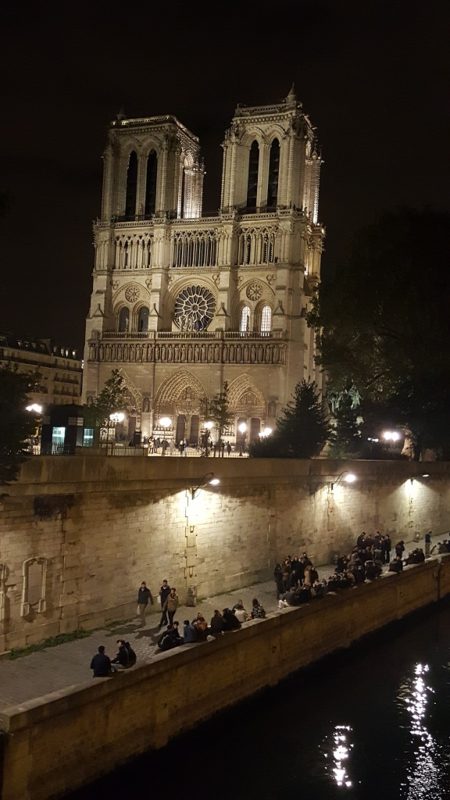
Notre Dame Is Even More Seductive at Night
From the Notre Dame Plaza we wandered by a jazz bar that was converted from a detention cell used in the French Revolution. It was interesting, but it did not call to us as much as continuing our mosey home. But, how’s that for repurposing?
Luxembourg Gardens was closed, yet on the outside it had a terrific exhibit with large photographs with explanations. All of the photos were taken from somewhere in France, mostly in rural areas and they had a focus on traditional skills, like weaving and slate roof building. The exhibit was very well done and informative. If nothing else, looking at the dozens of pictures made us realize how big France actually is and how much of it we haven’t seen. However the Catacombs and La Dame de Pic all in one day was a fabulous Parisian experience.
A three mile walk in Paris can yield a lot of sights, even at midnight. We used the Montparnasse Tower as a beacon of light to find our way home. In that regard, it is like a less enchanting Eiffel Tower.
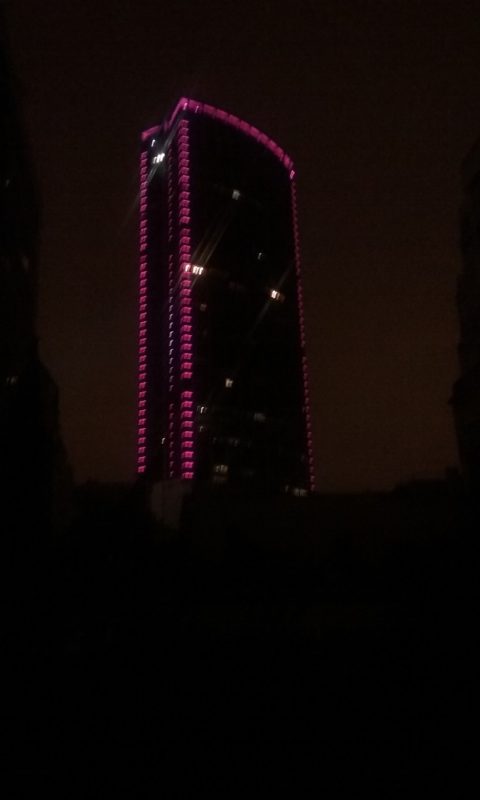
Tour Montparnasse Was All We Needed to Get Home
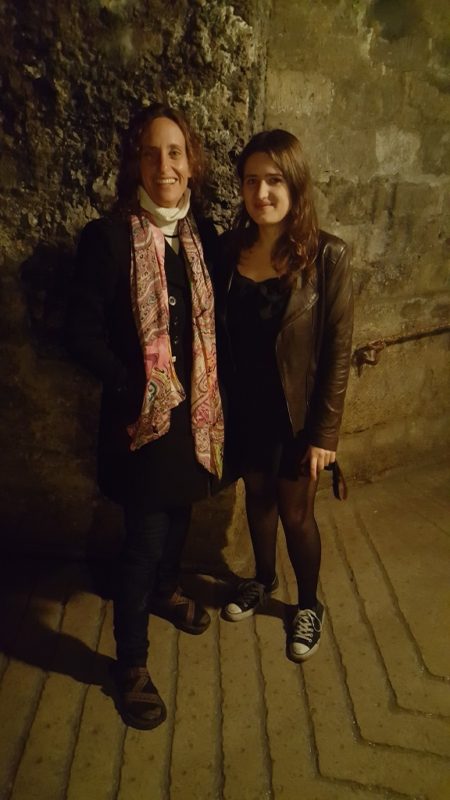
Victoire Was a Rocking Guide and an Inspiring Young Woman
 ?>/images/logo.520x200.jpg)